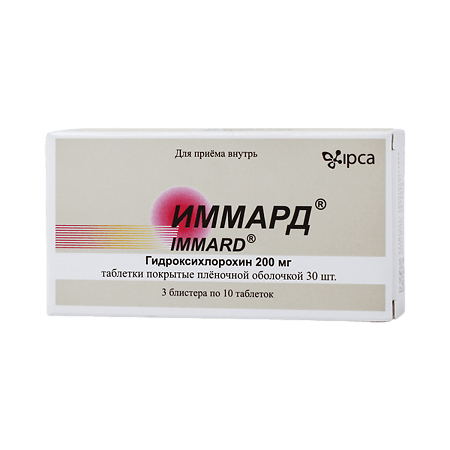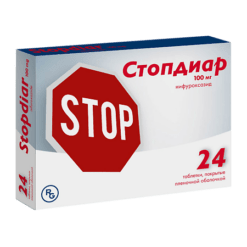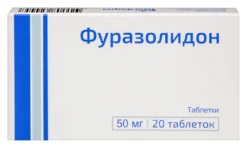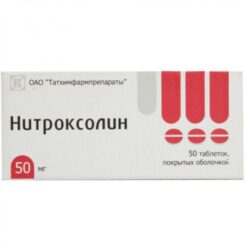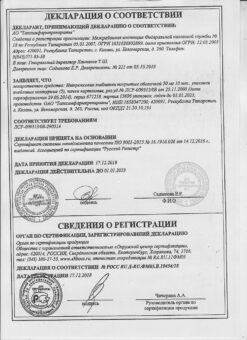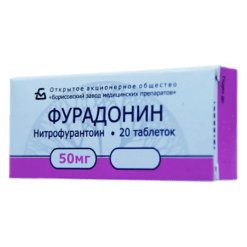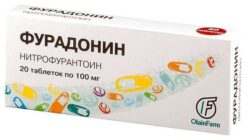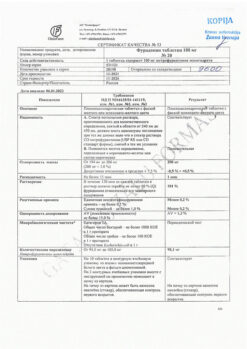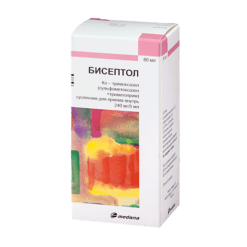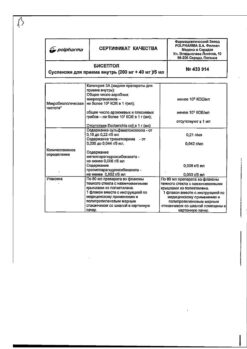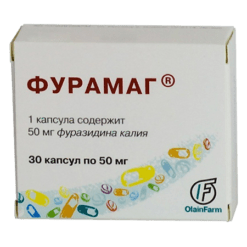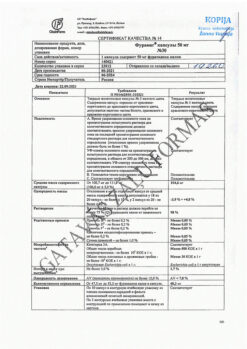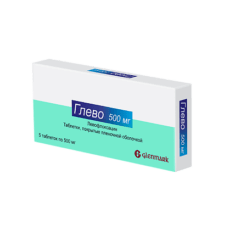No products in the cart.
Immard, 200 mg 30 pcs
€1.00
Out of stock
(E-mail when Stock is available)
Description
Antimalarial drug, actively suppresses erythrocytic forms (hematoschizotropic drug). It thickens lysosomal membranes and prevents release of lysosomal enzymes, disrupts DNA replication, RNA synthesis and Hb utilization by erythrocytic forms of plasmodium.
It also has immunosuppressive and anti-inflammatory effects, suppresses free radical processes, weakens the activity of proteolytic enzymes (protease and collagenase), leukocytes and lymphocyte chemotaxis.
Pharmacokinetics
Absorption is variable. Half-absorption period – 3.6 h (1.9-5.5 h). Bioavailability – 74%. Binding to plasma proteins – 45%. Time of reaching maximum concentration of the drug in blood (Tcmax) – 3.2 hours (2-4.5 hours), maximum concentration is (Cmax) after oral administration of 155 mg – 948 ng/ml, after oral administration of 310 mg – 1895 ng/ml. It accumulates in the tissues with high level of metabolism (liver, kidneys, lungs, spleen – in these organs the concentration exceeds plasma level 200-700 times; in central nervous system, erythrocytes, leukocytes) and in the tissues rich in melanin.
In very low concentrations it is found in the walls of the gastrointestinal tract.
Permeasures the placental barrier, in small amounts is determined in breast milk. Volume of distribution: measured in blood – 5.522 liters, in plasma – 44.257 liters.
Metabolized partially in the liver with the formation of active de-ethylated metabolites. Half-life from blood (T½) – 50 days, from plasma – 32 days.
It is excreted by the kidneys (23-25% unchanged) and in the bile (less than 10%). Excretion is very slow and may be long determined in the urine after discontinuation of treatment.
Indications
Indications
Rheumatoid arthritis; lupus erythematosus (systemic and discoid).
Juvenile arthritis. Hypercalcemia in a background of sarcoidosis.
Malaria: Treatment of acute attacks and suppressive therapy of malaria caused by Plasmodium vivax, Plasmodium ovale and Plasmodium malariae (excluding extra-erythrocytic forms and hydroxychloroquine-resistant cases) and sensitive strains of Plasmodium falciparum (excluding hydroxychloroquine-resistant strains); radical treatment of malaria caused by sensitive strains of Plasmodium falciparum.
Photodermatitis. Late cutaneous porphyria, chronic cutaneous vasculitis.
Contraindications: Hypersensitivity, pregnancy (can be used for “vital” indications), lactation, children (long-term therapy).
With caution. Retinopathy, changes of visual fields, suppression of medullary hematopoiesis, psychosis (including in anamnesis), porphyria, psoriasis, glucose-6-phosphate dehydrogenase deficiency, hepatitis, hepatic and/or renal insufficiency.
Active ingredient
Active ingredient
Composition
Composition
How to take, the dosage
How to take, the dosage
Overly, with a meal or with a glass of milk. 200 mg of hydroxychloroquine sulfate is equivalent to 155 mg of hydroxychloroquine base.
Rheumatoid arthritis: initial dose in adults is 400-600 mg/day, maintenance dose is 200-400 mg/day.
Juvenile arthritis: dose should not exceed 6.5 mg/kg or 400 mg/day (the lowest dose is chosen).
Discoid and systemic lupus erythematosus: initial dose for adults is 400-800 mg/day, maintenance dose 200-400 mg/day.
Photodermatosis: up to 400 mg/day. Treatment should be limited to periods of maximum sun exposure.
Malaria: suppressive therapy in adults is 400 mg/day every 7 days; in children (including infants) the weekly suppressive dose is 6.5 mg/kg, but regardless of body weight, should not exceed the adult dose (400 mg). If conditions allow, suppressive therapy is administered 2 weeks before exposure; otherwise, an initial double dose of 800 mg in adults and 12.9 mg/kg (but not exceeding 800 mg) in children may be administered, divided into 2 doses 6 hours apart. Supplemental therapy should be continued for 8 weeks after leaving the endemic zone.
The treatment of an acute malaria attack: the initial dose for adults is 800 mg, followed 6-8 hours later by 400 mg and 400 mg on days 2 and 3 of treatment (a total of 2 g of hydroxychloroquine sulfate). Alternatively, a dose of 800 mg once may be effective.
In children, a total dose of 32 mg/kg (but not to exceed 2 g) is administered over 3 days:
the first dose is 12.9 mcg/kg (but not to exceed a single dose of 800 mg),
the second dose is 6.5 mg/kg (but not to exceed 400 mg) 6 h after the first,
the third dose is 6.5 mg/kg (but not exceeding 400 mg) 18 hours after the second dose,
the fourth dose is 6.5 mg/kg (but not exceeding 400 mg) 24 hours after the third dose.
The dose for adults can be calculated per 1 kg body weight, the same as for children.
Interaction
Interaction
Increases plasma concentrations of digoxin.
Lincreases plasma concentrations of penicillamine and the risk of adverse effects from the hematopoietic organs, the urinary system and skin reactions.
Alkaline drinking and alkalis accelerate excretion.
It increases the effect of hypoglycemic drugs (requires reducing the dose of the latter).
The aminoglycosides increase the blocking effect on neuromuscular conduction.
The antacids decrease absorption (interval between their intake should be at least 4 hours).
Worsens the side effects of GCS, salicylates, class I a antiarrhythmics, hemato-, hepato- and neurotoxic drugs.
Special Instructions
Special Instructions
Ophthalmologic examination should be performed at least once every 6 months before and during therapy (use of daily doses greater than 6.5 mg/kg increases the risk of retinal damage).
In case of adverse reactions of the eye (decreased visual acuity, changed color perception, etc.) the drug should be stopped immediately (changes in the retina may progress even after withdrawal of the drug).
At all times during therapy it is necessary to monitor the blood cell composition and skeletal muscle condition (including tendon reflexes). In case of muscle weakness the preparation should be discontinued.
Contraindications
Contraindications
Hypersensitivity, pregnancy (can be used for “vital” indications), lactation, childhood (long-term therapy).
Side effects
Side effects
Musculoskeletal and nervous system disorders: myopathy or neuromyopathy leading to increasing myasthenia gravis and atrophy of proximal muscle groups; sensory disorders, decreased tendon reflexes, abnormal nerve conduction, muscle weakness; headache, dizziness, nervousness, psychosis, emotional lability, seizures, ataxia, irritability.
Sensory organs: tinnitus, hearing loss, photophobia, visual acuity disorders, accommodation disorders, corneal edema and clouding, scotoma; with prolonged use of high doses – retinopathy (including pigmentation disorders).Retinopathy (including pigmentation disorders and visual field defects), optic atrophy, keratopathy, ciliary muscle dysfunction.
Particular system disorders: CMD, AV blockade, decreased myocardial contractility, myocardial hypertrophy; with prolonged high-dose therapy – myocardiodystrophy.
Digestive system disorders: nausea, vomiting (rarely), decreased appetite, abdominal pain of spastic character, diarrhea; hepatotoxicity (liver dysfunction, liver failure).
Hematopoietic disorders: neutropenia, aplastic anemia, agranulocytosis, thrombocytopenia, hemolytic anemia (in patients with glucose-6-phosphate dehydrogenase deficiency), aggravation of porphyria.
Skin disorders: skin rash (including bullous and generalized). bullous and generalized pustular), itching, pigmentation disorders of skin and mucous membranes, hair discoloration, alopecia, photosensitization, Stevens-Johnson syndrome (erythema multiforme exudative), exacerbation of psoriasis (including with fever and hyperleukocytosis).
Others: weight loss.
Special Precautions
An ophthalmologic examination should be performed at least once every 6 months before and during therapy (use of daily doses greater than 6.5 mg/kg increases the risk of retinal damage).
In case of adverse reactions on the visual side (decreased visual acuity, altered color perception, etc.) the drug should be stopped immediately (changes in the retina may progress even after the drug withdrawal). During the therapy it is necessary to control the blood cell composition and skeletal muscles condition (including tendon reflexes) on continuous basis. In case of muscle weakness the drug should be discontinued.
Pregnancy and lactation use is possible only with vital indications (in therapeutic doses it may cause CNS damage in fetus or infant (including ototoxicity, auditory and vestibular, to deafness), retinal bleeding and pathological retinal pigmentation (infants are especially sensitive to toxic effects of 4-aminoquinolines).
During treatment it is necessary to exercise caution while driving vehicles and engaging in other potentially dangerous activities requiring increased concentration and rapid psychomotor reactions.
Overdose
Overdose
Symptoms: cardiotoxicity (Gis bundle conduction disorder; in chronic intoxication – myocardial hypertrophy of both ventricles), BP decrease, neurotoxicity (dizziness, headache, increased excitability, seizures, coma), visual disturbance, respiratory and cardiac arrest. Overdose is especially dangerous in young children, even taking 1-2 grams of the drug can be fatal.
The treatment includes gastric lavage, administration of activated charcoal (in a dose 5 times the dose of the drug), forced diuresis and urine alkalinization (e.g., ammonium chloride to pH – 5.5-6.5) increase urinary excretion of 4-aminoquinoline, symptomatic therapy (including administration of diazepam for convulsions, antishock therapy).
Control of sodium concentration in serum and constant medical monitoring for at least 6 h after the relief of symptoms are necessary.
Pregnancy use
Pregnancy use
Pregnancy and lactation use is possible only with vital indications (in therapeutic doses may cause CNS damage in fetus or infant (including ototoxicity, auditory and vestibular, to deafness), retinal bleeding and pathological retinal pigmentation (infants are especially sensitive to the toxic effects of 4-aminoquinolines).
Similarities
Similarities
Additional information
| Weight | 0.020 kg |
|---|---|
| Conditions of storage | The drug should be kept out of reach of children, dry and protected from light at a temperature not exceeding 25 ° C. |
| Manufacturer | Ipka Laboratories Limited, India |
| Medication form | pills |
| Brand | Ipka Laboratories Limited |
Related products
Buy Immard, 200 mg 30 pcs with delivery to USA, UK, Europe and over 120 other countries.

